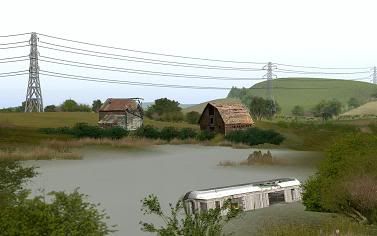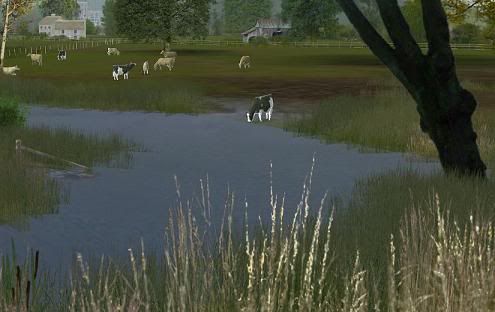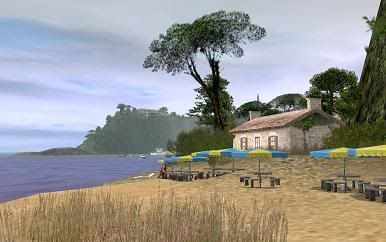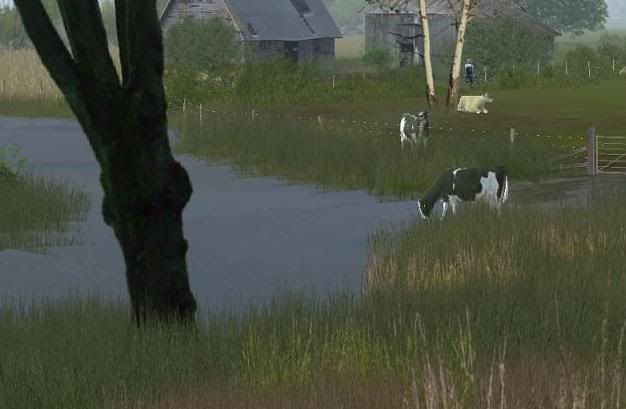Good afternoon everyone.
“Real” water or textures?
Both have their place. Both have advantages and disadvantages.
Textures work well, but beware of perspective distortion when viewing detailed textures from different angles.
Dinorius_Redundicus amply demonstrated, with some good illustrations in another recent thread, what can happen when some of these are not perfectly aligned, or have been incorrectly rotated.
Here’s an area from one of my routes using plain grey as water (no rotation problems there!) and capitalising on those spikey intrusions you get when textures overlap – I decided to use them as reflections.
“Real” water - the good bits:
- Looks correct at any angle.
- Works really well with textures laid on the river/sea bed beneath the water surface layer.
- Carefully sculpted river/sea beds can dramatically improve the water appearance. The reflective properties will look different depending on the underwater contour shapes which seem to cast shadows like hills, but below the surface, giving a nice variation in tone and colour.
- You can vary the surface conditions.
- The surface will reflect the sky which you have selected
- The tonal quality of the water colour changes as the day progresses
These are very powerful tools in the quest for realism and can significantly transform the image.
Here are few shots incorporating some of those techniques. The viewpoints are identical. Nothing has been changed, other than sky and time of day to illustrate the dramatic changes which can be achieved with the reflective ability of “real” water.
Hopefully you can see the clock for time of day. I've deliberately reduced the images to keep within the rules. I've also removed good weather fog, which I nearly always set, to show the full effect in these examples.
This second pair of shots better shows the reflective properties of the water, picking up both the colour and shapes of the cloud patterns.
The above shots had water set to the calmest level. The reflections are even more pronounced when there is some wave motion.
The bad bits:
I've never liked the “jitters” seen at the water’s edge when it meets a shallow shoreline. However, this flickering always looks worse in Surveyor than it does in Driver, where it generally doesn't show.
Slightly steepening the slope of the terrain into the water usually fixes it, or using a bit of texture which matches the water and gives a smooth transition between the two can work quite well.
Here’s an example of a cow standing at the water’s edge. His (sorry .. her!) feet are in the textured bit, but I’ve still got the advantage of the real water in the rest of the river with all of its benefits.
Some good weather fog has been turned back on together with some wave motion for the last few shots.
The angular shoreline edging caused by the constraints of the 10m or 5m grid squares are another minor irritation. This is relatively easily to minimise by adjusting the topography, but you can’t eradicate it completely.
You can cover it by planting some vegetation (fresh water only!)
With regard to water tiles being resource hungry, I can't say I've noticed this to be a problem. In my routes the major reason tends to be asset overload in certain parts (guilty as charged!) where I've had to do some serious culling.
As an experiment I’ve just just deleted the water tiles across 50 baseboards on one of my Italian coastal routes where I’ve extended as many as four baseboards offshore from the coastline to get a good and distant sea horizon. All were also textured, using just two texture kuid’s which can’t be deleted.
I can’t see any difference in performance. Not scientifically proven, but no worries from a user point of view. The lag still occurs in one of my densely populated coastal towns which is yet to be thinned out (spline walls and flower pots around every house etc. from my early days) but water does not seem to be the culprit.
Cheers
Casper












